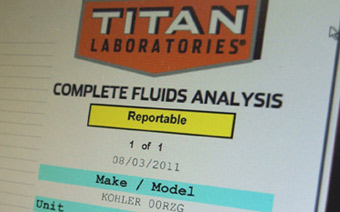EXPLANATION OF TESTS

EXPLANATION OF OIL ANALYSIS REPORT
Oil Analysis reports will provide you with the results of tests performed, evaluation, recommendation, and a cumulative history of previous tests to identify contaminants. Any tests that are outside normal limits will have a shaded box over the result.
PHYSICAL TESTS
- Viscosity cSt @ 100 ° C: Measures the flowability of an oil at a given temperature. High viscosity may be from extended oil change, or from an after market oil additive.
- Water: Presence of water may be from condensation or may be indicative of a coolant leak. Water is reported as a percentage. Too much water will make the oil cloudy and/or milky and will need to be changed.
- Fuel Dilution: Measurement of fuel in the oil. Reported in 2%, 5% or >10%. Small percentages of fuel may be from excessive idling. Excessive fuel may be from a mechanical problem that needs to be corrected. Excessive fuel will reduce the lubrication properties of the oil.
- Anti-Freeze: A chemical test is done to determine percentage of glycol in the system. Any amount of glycol is abnormal. Glycol contamination may result in filter plugging, overheating and overall internal engine wear.
OIL CONDITION
- Fuel Soot: Reported as % of weight. Soot is what makes diesel engine oil black. Soot needs to be controlled. Excessive soot can shorten engine life and will be very abrasive.
- Oxidation: Occurs when oxygen molecules join with oil molecules. Oxidation will make the oil thicker than normal and lose lubrication. It will be accelerated by high oil temperatures and glycol contamination.
- Nitration: Occurs in all engines, but is generally a problem in Natural Gas Engines. Nitrogen compounds from combustion thicken the oil and reduce lubrication.
- Sulfation: Sulfur is present in fuels and affects engines. Fuel sulfur oxidizes and combines with water to form acid during combustion. Acids corrode all engine parts.
SPECTROMETRY / ICP
We provide 23 elements on all of our reports. The measurement of these tests are in ppm (parts per million). The elements consist of wear, additive and trace elements. See origin chart for more information.
OPTIONAL TESTS
- TBN: Total Base Number. Measures the reserve alkalinity and should be compared to the new oil. A low TBN generally indicates a depleting additive package.
- TAN: Total Acid Number. Measure the amount of acidic products present in the oil. A high TAN will indicate oil needs to be changed.
- Karl Fischer Water: This test for water is very accurate. Will report water results in ppm (parts per million).
This analysis is intended as an aid in predicting mechanical wear. No Guarantee, expressed or implied, is made against failure of this component.
For additional information and specific interpretation contact the lab at 1-800-848-4826.
